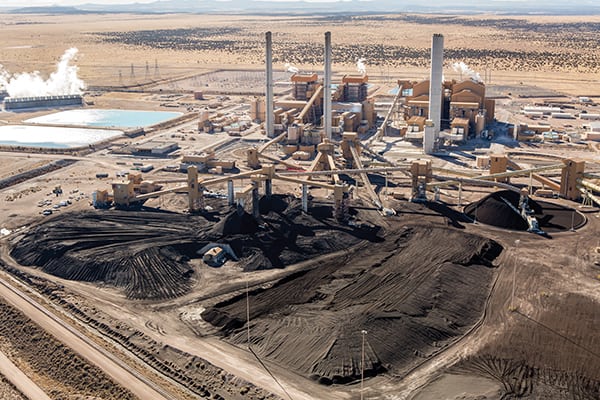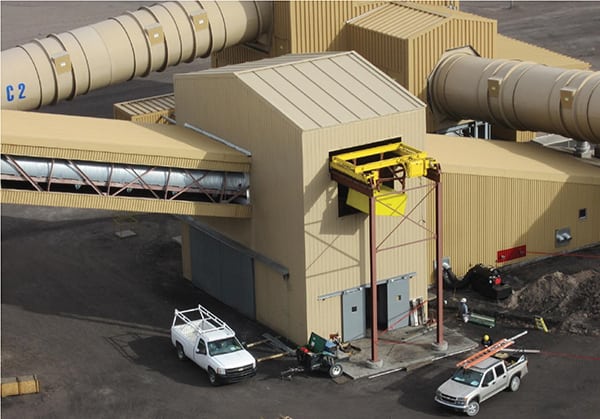Springerville Generating Station Earns PRBCUG 2014 Honors
The Springerville Generating Station has been a work in progress since the first unit entered service in 1985. The PRBCUG recently recognized Springerville with its 2014 Plant of the Year award for implementing industry best practices, continual improvements, and worker safety.
The presentation of the Powder River Basin Coal Users’ Group (PRBCUG) Plant of the Year award is always the highlight of the PRBCUG Awards Banquet, held the night before the kickoff of the Annual Meeting held in conjunction with ELECTRIC POWER Conference & Exhibition. Each year, since 2000, the PRBCUG has recognized one to two power plants for their innovation and the implementation of “best practices and continual improvements in areas including safety, environmental performance, coal handling, boiler and combustion, and risk management” for Powder River Basin coal (see sidebar). The selection is made after an extensive review by the PRBCUG Board of Directors. Membership of the PRBCUG is composed of users of PRB coals as well as prospective consumers (generating companies or industrial energy consumers).
| Benchmark Your PRBCUG Plant Against Industry PeersThe Powder River Basin Coal Users’ Group (PRBCUG) was formed to “promote the safe, efficient, and economic use of Powder River Basin coal by generating companies that currently use, or are considering the use of sub-bituminous coal.” One of the objectives of the group is to identify and establish industry best practices related to safe and efficient handling, burning, and using PRB coals.
Membership in the PRBCUG and attending the annual conference offers PRB coal users the opportunity to network with industry peers, learn from other operating plants, obtain access to industry best practice guidelines, and increase safety and risk awareness. Every plant that burns PRB coal will benefit to some degree from the insightful case studies on successful deployment of the right technology and industry best practices presented at the PRBCUG annual conference. Not every solution is appropriate for every plant, but there is one best solution for your particular “challenge.” And where better would you find peers to compare notes than with members of the PRBCUG? Additional information on the PRBCUG and its awards program is available at www.prbcoals.com. |
This year, the PRBCUG 2014 Plant of the Year was awarded to the Springerville Generating Station (SGS). SGS, located in the high desert of northeastern Arizona near the border with New Mexico, consists of four units with different owners but a single operator, Tucson Electric Power (TEP), a subsidiary of UniSource Energy Corp. Units 1 and 2 are sister units, each 380 MW. Unit 1, owned by a consortium led by TEP, and Unit 2, owned by TEP, were constructed in 1985 and 1990, respectively. Unit 3, rated at 417 MW, is owned by Tri-State Generation and Transmission and entered commercial service in the summer of 2006. Unit 3 is a prior recipient of POWER’ s Plant of the Year award (see “Tri-State Generation and Transmission Association’s Springerville Unit 3 Earns POWER’ s Highest Honor” in the September 2006 issue). Tri-State is a Denver-based wholesale power cooperative with member distribution systems in Colorado, New Mexico, Wyoming, and Nebraska. Unit 4, also 417 MW, was completed in December 2009 and is owned by Salt River Project, which is the third-largest public power utility in the U.S. (Figure 1).
All four units at SGS operate with an excellent heat rate under 10,000 Btu/kWh, and the plant’s 2013 net capacity factor was 80.3%, which ranks it as one of the best of its class, according to PRBCUG. The plant burns about 7 million tons/year of coal of which 3.7 million tons is PRB coal burned in Units 3 and 4. Units 1 and 2 burn coal sourced from the El Segundo Mine in northwest New Mexico. Coal is delivered by unit train and unloaded with a rotary car dump. The plant maintains seven separate coal piles and uses 51 conveyors to stack, reclaim, and move coal to each of the four units (Figure 2). Magnetic metals separation is also a recent addition (Figure 3).
The plant has 350 employees, including about 130 multi-skilled operators who are also trained to perform non-intrusive preventative maintenance (PM) evolutions that will take less than two hours (about 27% of all PM). SGS is very selective when it comes to new employees. New operators are hired from one of three sources: those completing a two-year training program, those with experience at other plants, or those with military experience. The plant also employs 120 contract employees, of which about 90 are employees of Southwest Energy Solutions, a TEP sister company. This team is responsible for plant housekeeping, ash handling, and mobile fleet operation and maintenance activities.
Recent Accomplishments
The coal unloading and transfer system is, for outage planning purposes, treated as a virtual “Unit 5,” and is scheduled for an annual outage lasting between four and 14 days. This approach allows SGS to plan, procure, and execute coal handling upgrades at predictable periods of time each year rather than piecemeal. Over the past few years, a number of upgrades have been completed that have significantly improved coal-processing operations:
■ Revised operation procedures reduced equipment wear and tear as well as subsequent housekeeping chores. The contractually required train-unloading rate is six to eight hours, but some operators would speed up feeders and conveyors such that a train was being unloaded in significantly less time. Fast is good, but only up to a point. Rapid unloading caused a significant increase in wear and tear on the equipment and increased fugitive emissions that overpowered the surfactant spray system, in addition to causing coal spills that required an additional six hours of cleanup. A simple operational change to limit the unloading feeder speed reduced coal-handling system operating and maintenance costs.
■ Installation of wireless vibration monitoring on all large electrical motors is expected to minimize unexpected catastrophic failures.
■ Standardized guarding around coal-handling equipment, conveyors, idlers, and tail pulleys were designed and installed. All the conveyor belts were also standardized. Also, water drain lines on the tripper decks and conveyors were increased in size to improve water removal as part of housekeeping. Cleaning these areas was problematic because water would not drain properly through too-small drains or those with too many bends. The end result was that housekeeping time for this task was reduced by 50%.
■ The housekeeping staff has been integrated into the safety culture of the plant. The 10 or so members of the housekeeping staff on duty at any time observe much of the plant everyday and report safety and maintenance problems as part of their work responsibilities. In addition, housekeeping staff are now assigned to a specific area of responsibility for two months rather than routinely rotated. The result is workers taking ownership of a particular area and better-maintained areas. One of the PRBCUG directors noted in his trip report that “the team that maintains the tripper gallery takes great pride in maintaining its cleanliness. I saw no coal dust on the walls nor on any exposed structural steel.”
■ An Engart dust extractor replaced two existing baghouse dust collection systems to improve safety, lower maintenance, and provide better dust collection efficiency. Winds that often exceed 60 mph at the site have necessitated other process improvements, such as adding dust suppression spray nozzles. Site drainage to the periphery of the coal storage areas was also added. In addition, F500 extinguishers were added around the entire coal storage area with training on how to use the extinguishers scheduled every six months.
■ Permanent vacuum lines were installed for areas that require routine cleanup. Also, LED lights were installed in many work areas. If you can’t see it, you can’t clean it.
■ SGS is located in the high desert—7,000 feet high. Winter temperatures are often below freezing, but many portions of the plant building were not designed to keep the heat in and the coal dust out. Portable heaters now keep unheated buildings above freezing and many conventional external doors, dangerous to open in high winds, have been replaced with sliding doors (designed with emergency escape features) that meet the life safety code. Elevated grating was also installed throughout the plant to improve traction when walking, particularly in conveyor areas.
Safety Is Valued
The plant’s incident and severity rates (currently 1.5 and 0, respectively) are historically well below the industry average and may also be considered as best in class, according to the PRBCUG. The plant’s safety organization each year selects a volunteer to be the plant’s “Safety Rover.” The Rover’s role is to spend the day where work is being performed in order to be a resource to workers in identifying and addressing potential hazards.
An employee-based safety program has been rolled out to workforce to encourage routine safety observations with immediate feedback to fellow employees. The Southwest Energy Solutions branch of SGS has achieved over 75% employee participation since 2012, while the TEP workforce implemented the program in January 2014. The observations are used to develop future safety education programs, improve job hazard analysis, and expand overall awareness of safety among the plant staff. Employees complete a job hazard analysis for each job prior to performing it. Signs are posted throughout the plant reminding employees that everyone has the authority, including contractors and visitors, to call a “Safety Time Out” when an unsafe work situation or act is observed.
The plant’s remote location requires self-protecting emergency preparedness and equipment. SGS houses onsite a stand-alone communication system (trailer), industrial fire brigade (advanced exterior and interior), and EMTs and two paramedics. The plant is equipped with trained personnel for fire, emergency medical, technical rescue, and hazardous materials, including specialized equipment and apparatus, all housed in an 11,000-square-foot building. Emergency Response Plans are in place, and drills are conducted regularly. A modern enhanced emergency notification system is interconnected to the plant’s GAI-Tronics system and communicates through four large speakers strategically placed around the facility. The emergency responders are embedded within the workforce 24 hours per day.
Sustained, Superior Performance
Congratulation to the Springerville Generating Station for being named the 2014 PRBCUG Plant of the Year. The award recognizes years of hard work by the plant staff and major capital investment by the plant owners to improve the performance and safety of the plant’s operations and maintenance. I’m told the Fuels Group set an internal goal to be named the PRBCUG Plant of the Year over two years ago—and reach that goal they did. The plant staff has demonstrated that relatively small, incremental improvements over time will pay huge dividends. Congratulations from POWER for a job well done. ■
—Dr. Robert Peltier, PE is POWER’s consulting editor.


